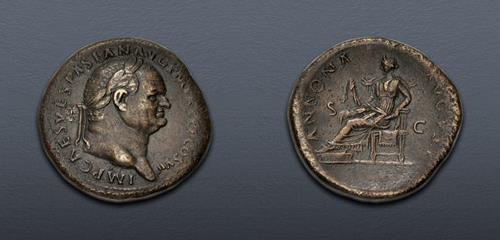|
Vespasian. AD 69-79. Æ Sestertius (33mm, 24.01 g, 6h). Rome mint. Struck AD 77-78. IMP CAES VESPASIAN AVG P M TR P P P COS VIII, laureate head right; eagle inset of the d’Este family behind head / ANNONA AVGVST, S C across field, Annona, draped, seated left, holding open on her lap a bag of grain ears, the ends held in her hands. RIC II 987; BMCRE 730 (this coin illustrated); BN 768. Even brown surfaces. Host coin VF, inset Good VF. Rare.
From the DMS Collection, purchased from Harlan J. Berk, January 2003. Ex Henry Platt Hall Collection (Part II, Glendining, 16 November 1950), lot 1173; Theodor Prowe Collection (28 November 1904), lot 2391; D’Este Collection, formed initially by Leonello d’Este (1407-1450), Marquis of Ferrara.
For many centuries, numismatists and scholars have debated the attribution of the distinctive eagle collector’s mark, found on the obverse of a small number of predominantly Greek and Roman coins. Attribution has been generally divided between two Italian noble families: the Gonzaga's, rulers of Mantua, which proclaims itself as the birthplace of the poet Virgil, and the Este family of Ferrara in northern Italy, which could trace its ancestry back to the 10th century. Much of the confusion stems from the intermingling of the Gonzaga and Este family collections in the 17th century. During the War of the Mantuan Succession (1628-1631), the Gonzaga coin collection was used as collateral by the embattled Duke Charles II Gonzaga of Nevers (1609-1631). It was during this tumultuous time in late Renaissance Italy that the Este family acquired the Gonzaga collection. The Gonzaga’s subsequently failed to recover their collection from the Este’s. Leonello d’Este (1407-1450) Marquis of Ferrara, initially formed what grew into a massive generational collection that was passed down through the Este family for centuries. Leonello began his collection with mostly bronze coins, such as the example offered here. Leonello acquired these earliest coins as a young man prior to 1430. Ercole I d’Este (1431-1505), Leonello’s half-brother, and Duke of Ferrara from 1471-1505, owned a collection of 437 gold coins by 1494. Some were notably acquired from the collection of Pope Paul II (d. 1471). Ercole’s son, Alfonso I d’Este, Duke of Ferrara from 1505-1534, enlisted the assistance of the lauded artist Raphael (painter of the famous The School of Athens in the Vatican library) to help him track down “antique medals, heads and figures.” A rough catalogue of the d’Este family collection was compiled between 1538-1541 under the direction of Ercole II d’Este (1508-1559), Duke of Ferrara from 1534-1559. The 1541 catalogue lists 783 ancient gold coins in the collection.
The collection continued to expand and reached its zenith under Alfonso II d’Este (1533-1597), Duke of Ferrara from 1559-1597.Some of the gold coins that are known today that feature the eagle inset appear in the 1541 manuscript. The absence of some of the coins that today bear the eagle inset supports a date for the inset’s application sometime after 1541. Enea Vico (1523-1567), who directed acquisitions for the d’Este family, referenced the collection in a 1563 writing that makes no mention of the inset. This again supports a slightly later date post 1563. A good possibility for the catalytic event that resulted in the inset’s application to these coins is an exhibition prepared by the famous artist and architect Pirro Ligorio (c.1510-1583). Ligorio, author of a number of famous manuscripts, worked under the patronage of the d’Este family in Ferrara between 1568 and 1574. It was while he worked for the d’Este’s, organizing the duke’s collections in his Antichario, that he compiled many of his famous manuscripts. Ligorio also served as the Vatican’s Papal Architect under Popes Paul IV and Pius IV.
From this evidence, scholars have concluded that the eagle inset did indeed belong to the Este family and was likely applied sometime between 1563-1614, perhaps during the tenure of Pirro Ligorio’s employment from 1568-1574. Later, in 1647, the Este’s recovered 710 pawned aurei with the eagle inset. Additionally, out of the 12,000–15,000 coins which at one time constituted the collection in its entirety, only around 1,500 were chosen to bear the eagle inset, applied in either silver or gold. Bronze coins, such as this one, are less commonly found from the d’Este collection wearing the eagle inset. Portions of the d’Este collection made their way into collections and museums in Milan, Modena, and Paris, as well as in Queen Christina of Sweden’s (1626-1689) personal cabinet of Roman coins. Apart from those collections, the remaining coins featuring the inset irregularly and infrequently appear on the market, such as this example which has been in sales since 1904. This is a rare chance to own a rare coin from a verifiable, famous, and coveted 15th century collection.
The final winners of all Triton XXVI lots will be determined at the live public sale that will be held on 10-11 January 2023.
Triton XXVI – Session Three – Lots 674-990 will be held Wednesday morning, 11 January 2023 beginning at 9:00 AM ET.
Winning bids are subject to a 22.5% buyer's fee for bids placed on this website and 25% for all others.
We recognize that our users may have various Internet Browsers and Operating Systems. We like our visitors to have the best possible experience when using our bidding platform. However, we do recognize that it is impossible to develop applications that work identically, efficiently and effectively on all web browsers. The CNG bidding platform supports the latest stable major version and stable previous version of Chrome and Firefox.
|
